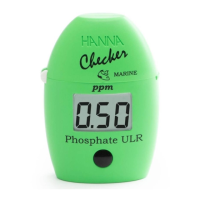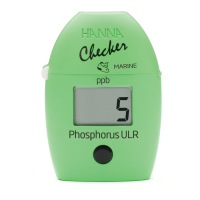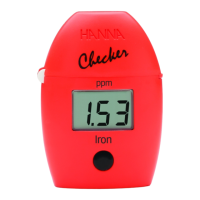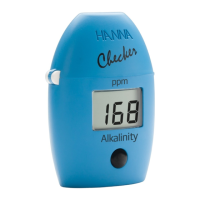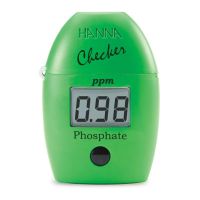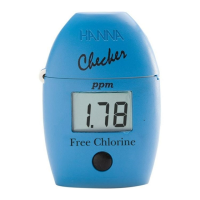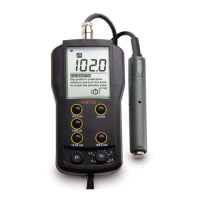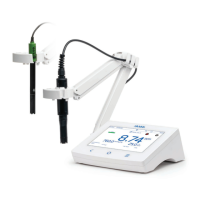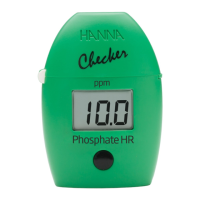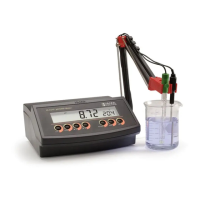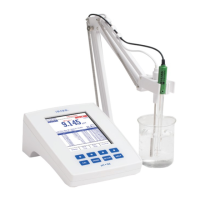
Do you have a question about the Hanna Instruments HI5221 and is the answer not in the manual?
| Brand | Hanna Instruments |
|---|---|
| Model | HI5221 |
| Category | Measuring Instruments |
| Language | English |
Front and rear panel details for the HI5221 model.
Front and rear panel details for the HI5222 model.
Explains the instrument's function and virtual keys.
Describes the LCD screen layout and displayed information.
Instructions on connecting the power adapter to the instrument.
Guides on connecting pH, ORP, ISE, and temperature probes.
Steps for powering on and initializing the instrument.
How to select and configure measurement channels on the HI5222.
How to configure the basic display of measurement data.
How to view detailed Good Laboratory Practice data on the LCD.
How to view logged data as a graph, on-line or off-line.
How to view past logged measurement data in a list format.
Steps to enter the System Setup menu.
Configuration options for audible alerts and warnings.
Setting to require user confirmation for changes.
Customizing GLP information for data logs.
Setting the instrument's current date, time, and format.
Adjusting contrast, backlight, and backlight saver settings.
Choosing from different color themes for the display.
Setting the display language for the instrument interface.
Configuring the baud rate for PC communication.
Viewing instrument serial number, software version, and calibration dates.
Resetting the instrument to its default factory configuration.
Instructions for updating the instrument's firmware via PC.
Steps to enter the pH Setup menu.
Saving, loading, and deleting measurement profiles for quick setup.
Configuring temperature source, unit, and manual compensation.
Setting buffer entry type and calibration reminder options.
Adding and editing custom pH buffer values for calibration.
Managing groups of pH buffers for automatic recognition.
Setting reminders for scheduled calibration intervals.
Defining the timing for calibration reminders.
Deleting existing pH calibration data.
Assigning alphanumeric IDs to samples and configuring increment mode.
Selecting criteria for measurement signal stability (Fast, Medium, Accurate).
Choosing between Direct and AutoHold reading modes.
Configuring logging type, data configuration, sampling period, and new lots.
Configuring alarm states (limits) and audible warnings.
Setting the electrode's isopotential point for accurate measurements.
Selecting the number of decimal places for pH readings.
Steps to enter the mV Setup menu.
Configuring temperature source, unit, and manual compensation for mV.
Setting calibration reminders and periods for Relative mV.
Steps to enter the ISE Setup menu.
Choosing from Direct, AutoHold, Known Addition, etc., for ISE measurements.
Configuring temperature source, unit, and compensation for ISE.
Enabling temperature compensation for ISE measurements.
Setting the ISE electrode's isopotential point when compensation is enabled.
Configuring manual entry modes (All Standards, Group Standards) for ISE calibration.
Adding and editing custom ISE standard values.
Creating groups of ISE standards for calibration.
Selecting the specific Ion Selective Electrode type used for measurement.
Setting ion-specific constants and molar weights for custom electrodes.
Setting the ion charge and slope for custom ISE electrodes.
Choosing the unit for displaying ion concentration measurements.
Setting the number of significant digits for ISE concentration readings.
Guidelines for preparing buffer solutions for calibration.
Step-by-step instructions for performing pH calibration.
Explanation of the elements shown on the pH calibration screen.
Explains common messages and error indicators during pH calibration.
Preparing standard solutions for ISE calibration.
Step-by-step instructions for performing ISE calibration.
Explanation of the elements displayed during ISE calibration.
Explains common messages and error indicators during ISE calibration.
Procedure for measuring pH using the direct reading mode.
Procedure for measuring pH using the direct/autohold reading mode.
Explanation of the "Outside Cal Range" warning message.
Introduction to mV/ORP measurement principles and procedures.
Procedure for measuring mV using the direct reading mode.
Procedure for measuring mV using the direct/autohold reading mode.
Procedure for measuring relative mV values.
Step-by-step guide for calibrating the instrument's temperature sensor.
Overview of how reading modes and logging work together.
Details on using Direct Reading with Automatic Logging.
Details on using Direct Reading with Manual Logging.
Details on using AutoHold with Automatic Logging.
Details on using AutoHold with Manual Logging.
Details on using AutoHold with Auto Hold Logging.
How to view stored log data and filter it by type.
Instructions for deleting logged data files from the instrument.
Information on connecting to a PC and using Hanna Instruments software.
Explanation of the principles behind Ion Selective Electrode measurements.
Overview of direct and incremental methods for ISE analysis.
Details on sample addition methods for ISE analysis.
Steps for preparing electrodes before use and storage.
Guidelines for performing measurements with electrodes.
Proper procedures for storing electrodes.
Routine inspection and maintenance of electrodes.
Specific maintenance tasks for pH probes.
Methods for cleaning pH electrodes.
Expected lifespan of pH electrodes based on temperature.
Explanation of alkaline error and its effect on pH.
List of available pH buffer solutions.
List of available electrode storage solutions.
List of available electrode cleaning solutions.
List of available electrolyte solutions for electrode refilling.
List of available ORP solutions.
Catalog of available pH electrodes with specifications.
Catalog of available ORP electrodes with specifications.
Information on extension cables.
List of other accessories.
